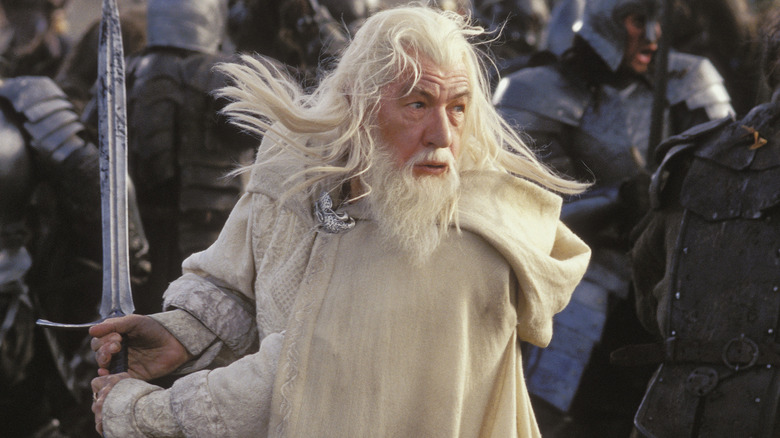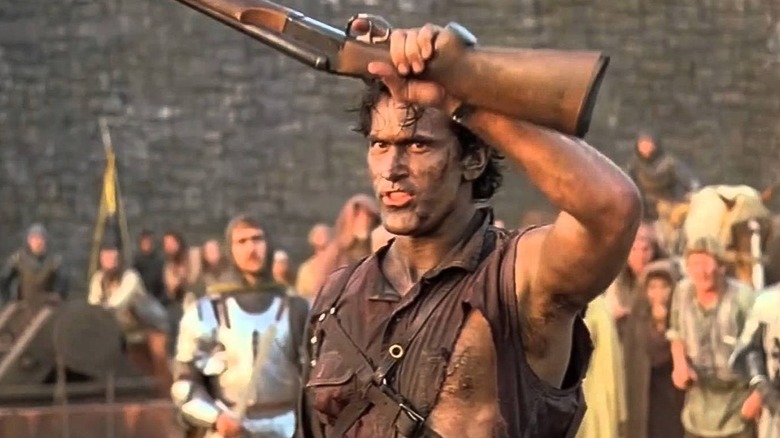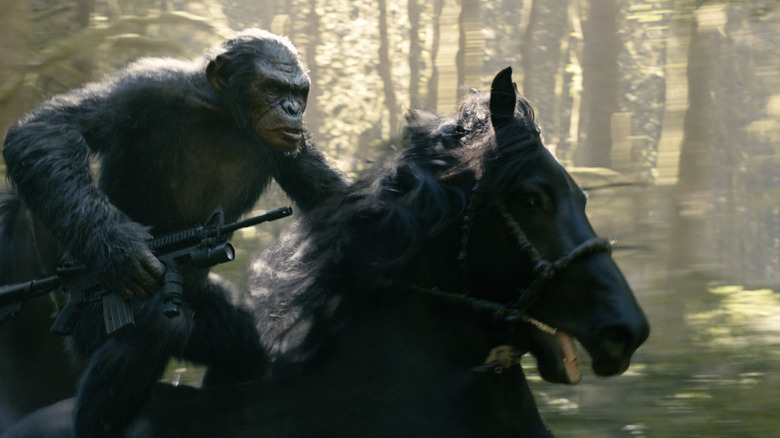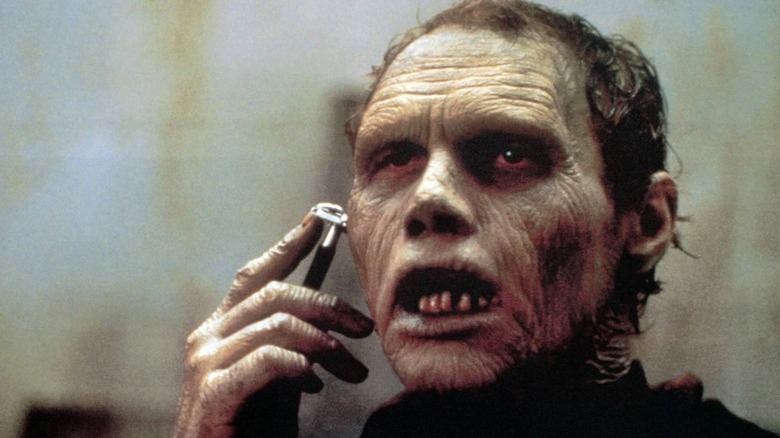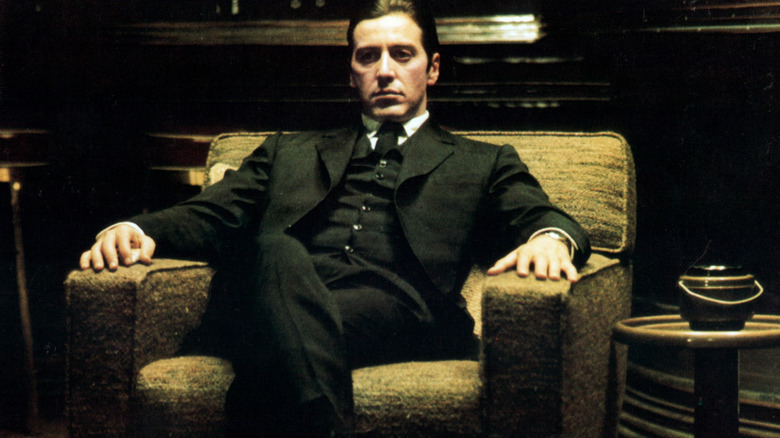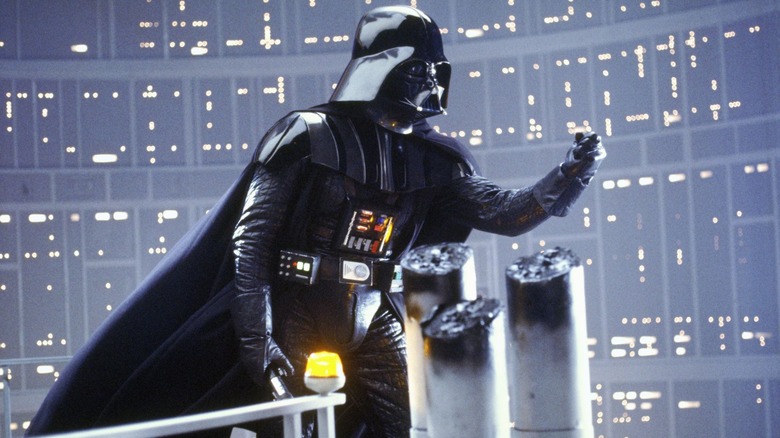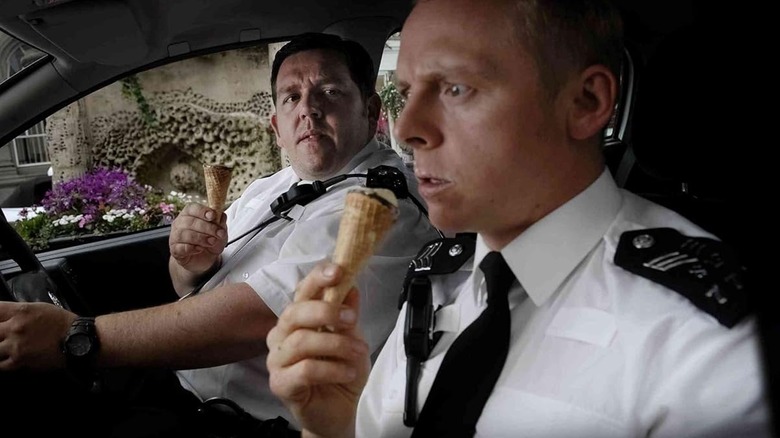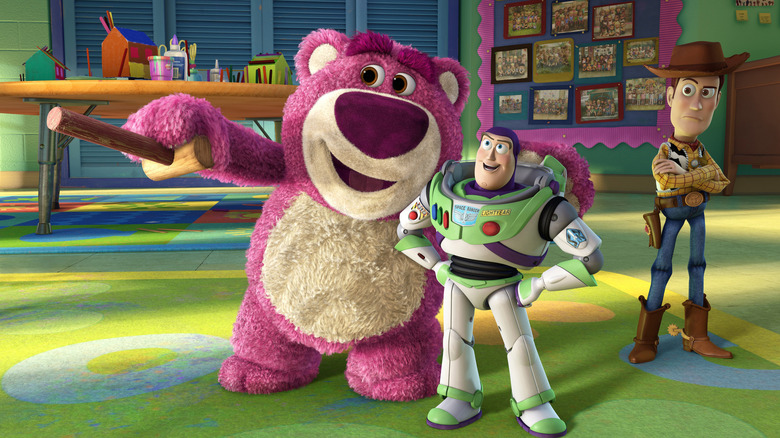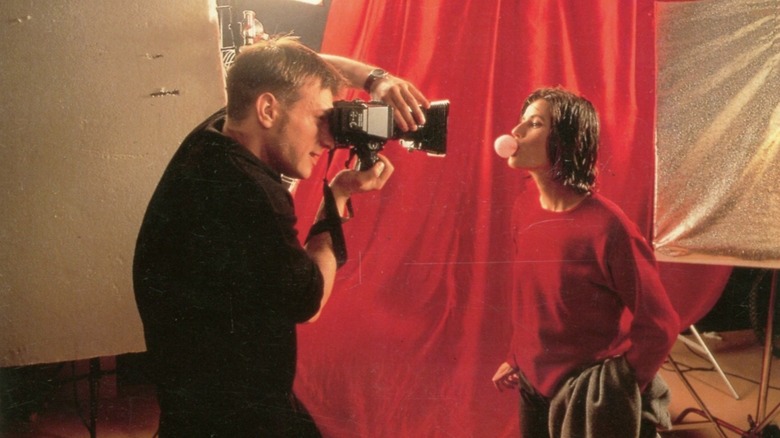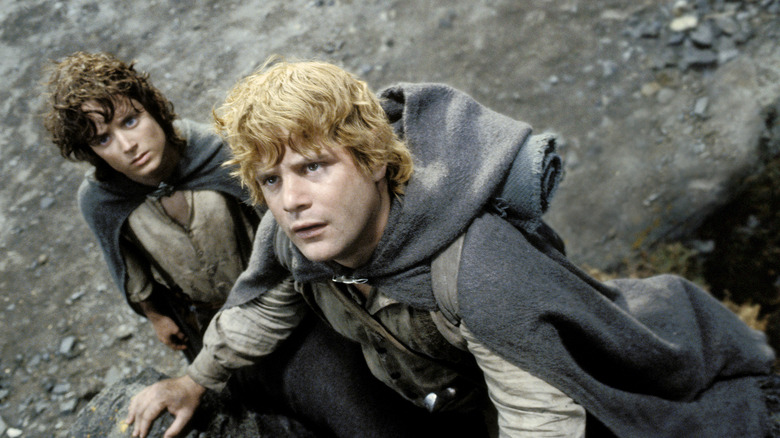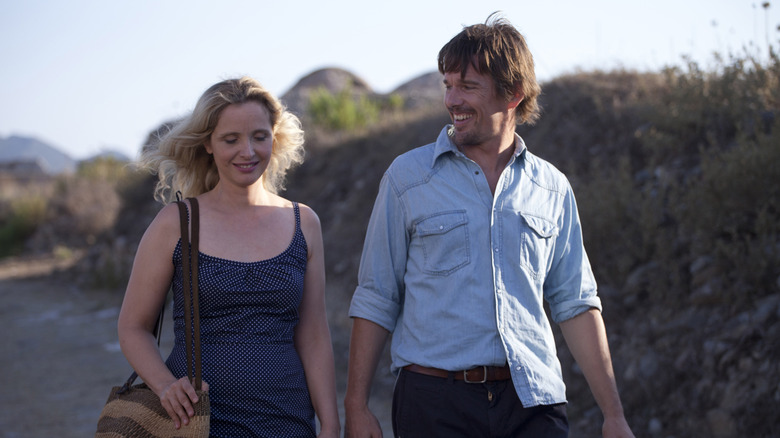12 Best Movie Trilogies Of All-Time Ranked
Looking at a typical list of the greatest films of all-time, one uncovers plenty of exciting reflections of how to create incredible, absorbing cinema. But what about those who dare to make more expansive forms of cinematic storytelling? What about those filmmakers brave enough to take on the task of creating an entire trilogy of motion pictures? Features like the worst horror movie sequels ever understandably give the very concept of follow-ups a bad name. Surely this is a domain that could only house uncreative rehashes of classic films. However, there aren't just good sequels out there, but entire outstanding trilogies. These sagas are sterling accomplishments that kept audiences captivated over many hours of storytelling, showing that sequels didn't just have to be hollow creative exercises.
There is no one way to make a great trilogy. Some of these collections of movies excelled because of evolving creative directions that ensured no two installments were exactly the same. Others leaned into masterful consistency that let audiences explore a richly defined, reliable world over the course of three movies. Still others succeeded by tapping into rich emotions that could only be accomplished with long-form storytelling. Whatever the reason, ranking these 12 greatest movie trilogies in history from "worst" to best reflects how it isn't necessarily a fool's errand to embark on a high-quality trio of interconnected motion pictures.
12. The Evil Dead Trilogy
Some trilogies start with grand ambitions and production value to spare. Sam Raimi's original trilogy of "Evil Dead" movies began with a pleasantly shoddy horror movie brought to life on pennies and inventive filmmaking. Who knew that "The Evil Dead" would eventually spawn a larger multimedia franchise with a sprawling narrative oriented around an original trio of "Evil Dead" movies? Even with so many "Evil Dead" features and seasons of television unleashed on the public over the years, these original three installments are still so special. Part of their success is down to the willingness of Raimi and company to always try something different with this saga, particularly with the riotously entertaining "Army of Darkness." Rather than confining evil to a single cabin in the woods, "Darkness" plopped protagonist Ash (Bruce Campbell) into an ancient medieval era.
This drastic shift in time periods epitomized the bold risks the "Evil Dead" trilogy always toyed with between grimly humorous shenanigans involving distorted bodies and gore. These three motion pictures also excelled as a showcase for Bruce Campbell's endearing talents as a leading man, with Campbell only getting more compelling the more ludicrous this trilogy became. There's no shortage of either "Evil Dead" films or horror franchises out there. However, this original cluster of "Evil Dead' adventures still remains in a class of its own, an impressive feat given its humble origins.
11. The Dark Knight trilogy
Two decades later, "Batman Begins" still stands out as a cracker of a superhero film. Christopher Nolan's inaugural foray into big-budget filmmaking still crackles with its emotional tangibility and riveting performances, particularly supporting turns from Michael Caine and Cillian Murphy. This superhero movie blockbuster kicked off one of the great modern trilogies, which also contained "The Dark Knight" and "The Dark Knight Rises." For the middle installment alone, the "Dark Knight" trilogy earns a spot on this list. Even aside from Heath Ledger's unforgettable turn as The Joker, "The Dark Knight" excels as a great crime feature so confident in its intimate turmoil that its finale zeroes in on a handful of people arguing in a loft.
For other superhero films, that would be the very definition of an anti-climax. For "The Dark Knight," it's just one of many bold turns that pays off divinely. "The Dark Knight Rises" is a step down from its predecessors, sure, but even here audacious creativity abounds. This includes the production's massive scope, Anne Hathaway's captivating take on Selina Kyle/Catwoman, as well as a radically new vision of Bane played with 110% commitment by Tom Hardy. All three movies have so profoundly infiltrated pop culture that it's easy to forget just how innovative the "Dark Knight" trilogy was at the time.
10. The rebooted Planet of the Apes trilogy
Even before 2011, there had already been several "Planet of the Apes" movies. The franchise had gone on for so long and even spawned a detested 2001 remake starring Mark Wahlberg. How do you make these features special again? "Rise of the Planet of the Apes" pulled off that magic trick with aplomb. Not only that, but it spawned a new trilogy of "Apes" movies, also consisting of "Dawn of the Planet of the Apes" and "War for the Planet of the Apes," which were truly remarkable motion pictures. These weren't just rehashes of what worked in the past. Focusing on the earliest days of a sentient ape society made the "Planet of the Apes" universe feel brand-new again. Plus, combining groundbreaking motion-capture technology with practical sets and emotionally real performances lent immersive pathos to the proceedings.
Best of all, the three movies provided a fascinating portrait of Caesar (Andy Serkis), the mythical figure of the original "Planet of the Apes" movies. From "Rise" to "War," Caesar undergoes a fascinating arc from being a tormented animal to a grand leader that people will write stories about for years to come. It's a deeply compelling version of the character handled with grace by Serkis. Watching Caesar's transformation alone solidifies this trilogy as an ingenious extension of the familiar "Planet of the Apes" universe.
9. The Guardians of the Galaxy trilogy
Many trilogies exist within the Marvel Cinematic Universe, though most of them don't quite work as standalone trilogies. Something like the original "Captain America" trilogy is built too much on other productions to function as exemplary in its own right, for example. The "Guardians of the Galaxy" trilogy, meanwhile, was always designed to exist in its own little MCU corner by writer/director James Gunn. Because of this, the trio of cosmic superhero films flourishes artistically more than any other MCU trilogy. There's such profound emotional joy in watching these ragtag outer space misfits grow closer to each other over three stories. To boot, witnessing actors like Karen Gillan, Dave Bautista, and Pom Klementieff grow increasingly comfortable in their respective roles is also a gift.
Best of all, the "Guardians of the Galaxy" trilogy actually builds up to an emotional climax across one larger story. Even with greater MCU machinations seeping into "Guardians of the Galaxy Vol. 3," this small saga still feels like it's grooving to its own tonally varied rhythm every step of the way. Oh, and we can't forget about the outstanding soundtracks that permeate each "Guardian of the Galaxy" installment — artists ranging from Cat Stevens to Hatsune Miku are deployed perfectly. Put simply, this trilogy rocks harder than any other MCU trilogy out there.
8. Romero's Dead trilogy
Horror master George A. Romero worked regularly with zombies and movies in the "Dead" franchise right up until his final directorial effort, 2009's "Survival of the Dead." However, arguably his greatest creative accomplishments lie in his original trilogy of zombie-based films. Encompassing "Night of the Living Dead," "Dawn of the Dead," and "Day of the Dead," these three films create a trilogy that's already remarkable just in raw quality alone. Each of these motion pictures is a divine cinematic treat. However, considering they were all created in different decades, they also each represent excitingly new visions of zombie mayhem. "Night of the Living Dead's" monochromatic intimate gaze showing horrors unfolding in a "tranquil" house, for instance, eventually evolves into "Day of the Dead's" colorized underground apocalypse where even military might succumbs to paranoia and betrayal.
Over this trilogy, the practical effects and graphic death scenes only get more imaginative, while the constantly shifting casts for each production ensure viewers get to experience a wide array of memorable characters. This includes "Day of the Dead's" Bub the zombie, an incredibly unforgettable figure who gets to deliver one of the great crowd-pleaser horror cinema moments. For vivid proof of Romero's horror mastery, just witness how his craft manifests throughout this trilogy of "Dead" installments.
7. The Godfather trilogy
Unlike most trilogies on this list, the trio of "Godfather" features has an indisputable clunker in the form of "The Godfather: Part III." This 1990 sequel just didn't have the quality of its predecessors thanks to a variety of problems, including the lack of "Godfather" supporting actor Robert Duvall. Still, even this underwhelming entry has many virtues that put other movies to shame, including its incredibly dark ending that serves as a fitting capper to this saga. Plus, the first two "Godfather" features remain such outstanding motion pictures that there's no way this list couldn't include the "Godfather" saga. Mario Puzo's original book was translated to the silver screen with impeccable style by director Francis Ford Coppola and company into a remarkable epic about how good men become monsters even in "the land of opportunity."
Those first two "Godfather" installments especially excel decades later as showcases for some of the greatest actors of all-time, including John Cazale's richly human and vulnerable work as Fredo. Meanwhile, Marlon Brando still earns every word of hype for his magnificently towering yet down-to-earth performance as Vito Corleone. Such tremendous turns are filtered through cinematography and editing that's still incredibly impactful even if you've seen these films dozens of times. Even with "Part III," "The Godfather's" guns and cannolis make it absolutely divine cinema.
6. The original Star Wars trilogy
Before the prequels, before the internet toxicity, before the endless streaming shows, there was just the original "Star Wars" trilogy. "Star Wars," The Empire Strikes Back," and "Return of the Jedi" didn't just inspire a mega-empire of merchandise and moolah. They were also exceptional pieces of filmmaking, particularly those first two installments. "Star Wars" is pure popcorn escapism that clicks together oh so sweetly. Its sincere approach to classical adventure storytelling is irresistible all these decades later. Rather than just rehashing what worked before, "Empire Strikes Back" takes this universe into fascinatingly darker directions. Moral complexity seeps into this Campbellian land, as do legendary new supporting characters Lando Calrissian and Yoda.
Just "Star Wars" and "The Empire Strikes Back" would be enough to solidify the original "Star Wars" trilogy a place on this list. However, "Return of the Jedi," though not up to the standards of its predecessors, is still a winner in many respects. Its gloriously elaborate practical effects remain dazzling and there are incredibly exciting action set pieces scattered throughout its run time. Awe-inspiring wonder and memorable imagery abounds even in the trilogy's weakest entry. Meanwhile, at the pinnacle of its creative prowess, the original "Star Wars" trilogy effortlessly reminds viewers why this galaxy far, far away permanently altered pop culture forever.
5. Three Flavours Cornetto trilogy
From 2004 to 2013, the Three Flavours Cornetto trilogy hit the silver screen courtesy of director Edgar Wright, who also penned each script in this saga alongside franchise leading man Simon Pegg. Consisting of "Shaun of the Dead, "Hot Fuzz," and "The World's End," these titles were remarkable achievements showing insightful understanding of how genre domains like zombie films, action flicks, and sci-fi invasion stories operated. They skewered the hallmarks of these cinematic domiciles, but also delivered so much excitement and laughs that audiences were reminded why they loved these kinds of titles in the first place. Other filmmakers would struggle to balance satire with tangible affection. For Wright, it came naturally.
The Three Flavours Cornetto trilogy is an absolutely dynamite collection of movies crammed full of some of the best gags in the history of comedy cinema, like "Hot Fuzz's" jokes about a local suspicious grocery store owner being "a slasher ... of prices!" They're also an amazing demonstration of leading men Pegg and Nick Frost's talents, with the duo showing extraordinary versatility across their various Cornetto characters. On top of all that, the camerawork and editing throughout this trio of features never falls short of exemplary. One of the most entertaining trilogies ever, the Three Flavours Cornetto movies are simply delectable.
4. The original Toy Story trilogy
With "Toy Story 5" on the way for June 2026, it's clear this saga about toys coming to life and getting into adventures when kids aren't looking will never end. As long as the box office figures remain high and youngsters ponder the interior lives of their playthings, Disney and Pixar Animation Studios will keep coming up with new "Toy Story" outings. No matter how long this saga goes on, though, nothing can dilute the specialness of that original "Toy Story" trilogy. The inaugural three installments of this franchise function as their own story about Woody (Tom Hanks) and Buzz (Tim Allen) coming to terms with their owner Andy inevitably growing up. While other animated properties like "The Simpsons" or the "Despicable Me" movies permanently freeze their characters at one age, these three "Toy Story" features emphasized the inescapably terrifying march of time.
Spanning 15 years, the initial "Toy Story" trilogy is a remarkably moving ode to mortality, loss, and growing up. It's not all existential crises, though, as it consistently delivers hysterical new toys such as Tour Guide Barbie (Jodi Benson), Ken (Michael Keaton), and Mr. Pricklepants (Timothy Dalton). The laughs and endearing playthings are plentiful in this trilogy, which just makes the staggering emotional power of entries like "Toy Story 3" so astonishing. There's no way to stop the "Toy Story" saga, but it's doubtful this franchise will ever top the original trilogy of masterpieces.
3. Three Colours trilogy
We're all intertwined. Every living soul inhabits the same planet and our lives have ripple effects on others, whether we like to recognize it or not. This is one of many fascinating thematic facets to writer/director Krzysztof Kieślowski's "Three Colours" trilogy. An exploration of the ideals defining the French Republic, this saga begins with "Three Colours: Blue," a meditation on suppressed survivor's guilt. Julie's (Juliette Binoche) buttoned-up and externally aloof approach to coping with the loss of her husband and daughter in a car accident inspires "Blue's" fascinating atmosphere. Her experiences also inform this title's very distinctive color scheme, which relies heavily on blue hues in everything from production design to the costumes. It's not the last time a "Three Colours" installment uses pronounced hues to establish an idiosyncratic visual identity.
Across all three "Colours" movies, striking cinematography and color choices are omnipresent. These qualities become especially apparent in the trilogy's greatest installment, "Three Colours: Red." The capper to this intimate cinematic group also turned out to be Kieślowski's final directorial effort. What a swan song to go out on, as "Red" poignantly and quietly explores an unexpected friendship blossoming between a woman and an eavesdropping old man in an age of rapid technological advancement. Watching these two slowly but surely unite encapsulates the unexpected bonds and human intersections driving the masterful "Three Colours" trilogy.
2. Lord of the Rings trilogy
In the modern world, audiences have witnessed countless examples of big-budget long-form franchise filmmaking going off the rails. The "Star Wars" sequel trilogy ended on a cataclysmic note with "The Rise of Skywalker," while the "Divergent" saga never got to wrap up thanks to "Allegiant's" dismal box office results. These facets of reality make it all the more shocking that the "Lord of the Rings" trilogy was not only completed but turned into an extraordinary artistic accomplishment. Director Peter Jackson's adaptation of the original J.R.R. Tolkien novels was a sweeping fantasy odyssey that made Middle-Earth a location you could reach out and touch. Across three dizzying masterpieces, Jackson delivered a toweringly epic scope without ever neglecting the intimate material related to captivating characters like Gollum and Samwise Gamgee.
While other franchises (even that "Godfather" saga) end on a dour, underwhelming note, "The Lord of the Rings: The Return of the King" concluded these features with tremendous finesse, full of instantly unforgettable lines like "but I can carry you!" and tear-inducing moments of pathos. For those who thought Tolkien's words could never properly exist in live-action, this "Lord of the Rings" trilogy was an exciting surprise that forever changed fantasy cinema. It also set a high bar for modern blockbuster sagas that few other franchises have come close to matching.
1. Before trilogy
The greatest film trilogy in history begins in 1994 on a train in the movie "Before Sunrise." By chance, Jesse (Ethan Hawke) runs into a woman named Celine (Julie Delpy) and they start talking. Initially, it looks like their chat will end once Jesse gets off at his stop. Once they arrive, Jesse asks Celine to walk with him. "Think of it like this: jump ahead, ten, twenty years, okay, and you're married. Only your marriage doesn't have that same energy that it used to have, y'know," Jesse explains, "You start to think about all those guys you've met in your life and what might have happened if you'd picked up with one of them, right? Well, I'm one of those guys." This explanation works. The two begin walking around Vienna. So begins the love of Jesse and Celine, which informs the "Before" trilogy and its subsequent installments, "Before Sunset" and "Before Midnight."
After "Before Sunrise" debuted in 1995, there would be a nine-year wait between each of its follow-ups. With these prolonged gaps, Jesse and Celine age before the viewer's eyes, going from college-aged kids in the first installment to "Before Midnight's" married couple with children. Writer/director Richard Linklater's intimate gaze as a filmmaker is put to extraordinary use across each of these films, as he uncovers rich personality and interiority in every tiny gesture Jesse and Celine exhibit. Love and all its complexities have rarely been more entrancing cinematically than in the outstanding "Before" trilogy.
